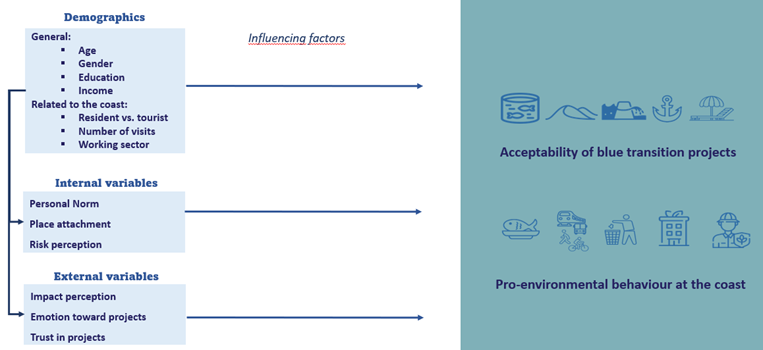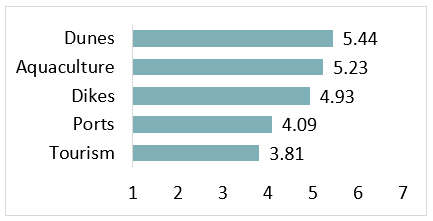Main survey results
UGent Department of Communication Science conducted a large survey among residents and tourists of the Belgian coast to examine all potential factors influencing people’s acceptance for blue transition projects (and for pro-environmental behaviour). The results are summarised below with some initial guidelines on how to engage the public on the respective projects. These conclusions are based on the significant findings and have been simplified to highlight the main points, while attempting to maintain nuance. For a comprehensive overview, including detailed data and scientific numbers, we refer to the full report.
Overview of the influencing factors
Demographics, internal, and external variables are important in explaining people’s acceptance for the blue transition projects (and for pro-environmental behaviour). Each of the variables have their own importance, depending on the specific project (aquaculture, natural dunes, dikes, ports, and tourism). The results were obtained from a large survey (n = 1452) from February until April 2023. It was a representative sample were we both questioned residents (36%) and tourists (64%) of the Belgian coast.
Main conclusion
There are a lot of different sectors located at our Belgian coast. This diversity was also found in our results, so a one-size-fits all communication strategy will not be sufficient. It is important to acknowledge the variety of projects and how Belgian coastal tourists and residents perceive each of these projects. In particular, we found that these projects can be situated on a continuum (dunes – dikes – aquaculture – ports – tourism), with on the left side the projects accepted by people with a strong coastal/environmental identity, and on the left the more economically oriented people. Within this continuum, we see that other variables are more important in predicting the acceptance of this project. We will add nuance to this in the following sections. We did see some overall trends, such as risk perception and positive beliefs about the projects being important throughout the continuum. But even then, these risks and impact perceptions need to be adapted to the specific projects.
Acceptability of the projects
Survey question: “Do you accept the following projects?” (1 = not at all, 4 = a bit, 7 = very much)
Acceptability of coastal protection (dunes & dikes)
Results
These projects are generally accepted and even more so by individuals who have familiarity with the Belgian coast. There seems to be an overall clear understanding of the need to protect the coastal region against sea level rise (even more for people with high risk perceptions and a high place identity to the Belgian coast). Dunes are more accepted than dikes, maybe due to wider perceived (environmental) benefits (note that we had framed the projects as ‘sustainable projects’), but the acceptability of any specific (coastal protection) project is likely to decrease if people perceive that it will negatively affect their lives.
Communication strategy
- Shared factors between dikes & dunes: emphasise sea level rise risks and the potential positive impact of these projects
- Local residents: protecting both property and lives along the coast
- BUT also consider the tourists, as their perception may differ due to the perceived distance from the coastal protection measures (acceptance for dunes was a bit higher for residents): how will they also benefit from coastal protection measures?
- Dunes
- Emphasise place identity.
- Explain impact on other activities along the coast in particular, how the dunes can co-existence with these other activities to counter potential perception that dunes are a barrier to people’s own activities or to human activities in general (i.e. for those people who exhibit high place dependence, risk perception of economic decline and/or trust in project developers)
- Side note: more pro-environmentally minded people already seem convinced of the benefits of the dunes for nature
- Dikes: There may be a negative association with personal norms (= feeling a responsibility for the health of the coastal environment). So, explaining how dikes can contribute to the overall environmental wellbeing of the sea/coast may also increase acceptance.
Acceptability of aquaculture
Results
Aquaculture seems generally accepted, like the coastal protection measures. These are no significant differences between tourist and residents on the acceptance of aquaculture. Only (negative) impact perception and emotion have a relatively strong role in predicting acceptance. As aquaculture projects are new along the Belgian coast, the lack of other significantly strong predictors may suggest a lack of general awareness and knowledge about aquaculture. Hence people may have less formalised views regarding aquaculture.
Communication strategy
- Educate the public (both residents and tourists) on aquaculture projects along the Belgian coast
- Strengthen the already positive beliefs about the impact of aquaculture
- Highlight the co-benefits of aquaculture, with a special focus on: Co-existence with other activities for those people who might perceive aquaculture as a barrier to their own activities or to human activities in general (i.e. those with a higher place dependence)
- Make aquaculture part of the Belgian coast identity
Acceptability of ports
Results
Acceptance of ports appears to be higher compared to tourism development. A relatively strong role is played by impact perception and emotion in predicting acceptance of port expansion. One possible explanation for this difference is that fewer people are likely to be directly affected by the expansion of ports compared to tourism development. However, the framing used to describe port expansion in the survey — such as emphasizing its connection to wind farms — may contribute to higher levels of acceptance. While risk perception related to economic decline also influences acceptance of ports, this effect is very small, especially when compared to its relatively strong influence on tourism development. Ports are generally perceived as vital for the coastal economy but less directly relevant to individuals. This distinction may further explain why port expansion tends to face less objection than tourism-related projects.
Communication strategy
- Focus communication efforts to the communities neighbouring ports that would be directly affected by any port expansion
- Careful framing of ‘sustainable’ port expansion
- Acceptability of port expansion will likely depend on how the activities for which the port expansion is required are perceived
- Demonstrate wider beneficial effects on local communities and on the environment (or at least how any negative impacts have been minimised)
- People with a high place dependence, who love the coast for its activities and the instrumental benefits, are possibly worried that the ports will take even more place – emphasizing co-benefits or at least how they will be affected, and possible multi-use?
Acceptability of tourism
Results
Tourism is the least accepted form of coastal development, particularly among individuals with strong familiarity with the Belgian coast and high place identity. While tourism is perceived as important for maintaining a thriving coastal econom — evidenced by the significant role of place dependence and economic decline risk perception in predicting acceptance — it is also associated with negative environmental impacts. These impacts may contribute to the perception that tourism development is not aligned with sustainability goals. However, the framing used to describe tourism projects in the survey may have influenced these attitudes, further reducing acceptance levels.
Communication strategy
- Careful framing of ‘sustainable’ tourism, especially for the residents and the environmentally minded people will likely be difficult to ‘sell’ the expansion of tourism as a sustainable project to these people
- Need to change the image/perception of tourism?
- Highlight the co-benefits of ‘sustainable’ tourism, with a special focus on:
- Minimal to beneficial environmental impact
- Minimal to beneficial impacts on the local communities
- People who are already accepting the development of tourism seem less worried about sustainability or the coastal identity, but more about the risk of economic decline
Demographics
We found that there are some differences between those who feel familiar with the coast (residents, frequent visitors, people working in the marine sector) and those who are not. People with a higher familiarity with the Belgian coast will accept more the building and heightening of natural dunes and will accept less the further development of tourism. These people will also act in a more pro-environmental way related to coastal behaviours like choosing sustainable seafood options, public transport, picking up litter, and volunteering for environmental organisations.
People with a higher familiarity with the Belgian coast will have a higher place attachment to the place, are more perceiving natural risks such as sea level rise and marine life decreasing and have a higher personal norm (= feeling a responsibility for the health of the coastal environment). People working in the marine sector think more about the positive impacts of certain projects, in contrary to the frequent visitors and residents who are not working in the marine sector. They think more about the overall impact (both positive and negative) of the projects and have less trust in project developers. It is possible that people working in the marine sector have more knowledge in these projects, are more involved, being a project developer themselves or having a higher belief in technology.


